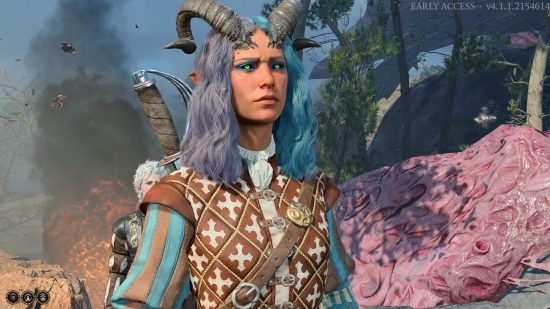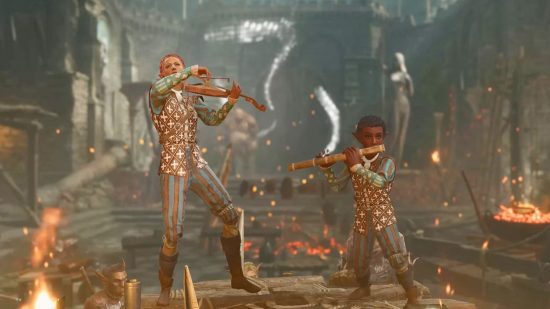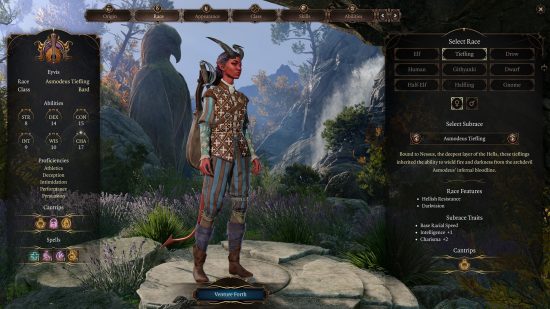What’s the best Baldur’s Gate 3 Bard build? Our guide provides an overview of the Bard, going into detail about each of the class features, mechanics, and subclasses on after. We also create the best build by looking at the College of Valour subclass, as well as the top selections for races, abilities, and spells.
The Baldur’s Gate 3 Bard performs tunes to buff teammates, while also insulting and demoralizing foes. If you’ve come with curiosity from our Baldur’s Gate 3 classes overview, we’ve got more details on how to build a specific Bard build to make the best of the musical mage, including which of the BG3 races to pair it with, so – for you fans of alliteration – here’s the best BG3 Bard build.
Best BG3 Bard build guide
The best Baldur’s Gate 3 Bard build is:
- Subclass – College of Valour
- Race – Wood Half-Elf
- Background – The Entertainer
- Skills – Acrobatics and Performance
- Spells – Healing Word, Heroism, Dissonant Whispers, Thunderwave
Best Bard subclass
The best Bard subclass in Baldur’s Gate 3 is the College of Valour. It has the following perks:
- Combat Inspiration – Applies the default Bardic Inspiration effect to an ally, as well as the option to add +1d6 to the damage of their next weapon attack, or to their armor class (AC) for one attack.
- Medium Armor Proficiency
- Shield Proficiency
- Martial Weapon Proficiency
The Bard has two subclasses: College of Lore and College of Valour. You can choose either of these once you reach level 3. The College of Valour proficiencies alone make the Bard more suitable for combat, giving you the option to take the fight to your foes. Comparatively, the College of Lore is mostly if you want to make the Bard succeed in a variety of skill checks. As such, it firmly relegates the class to a pure support role.
Best Bard abilities
The best stats for Bard are:
- Strength – 10
- Dexterity – 15
- Constitution – 14
- Intelligence – 10
- Wisdom – 10
- Charisma – 16
The Baldur’s Gate 3 Bard relies primarily on charisma for spellcasting. Dexterity is also important for initiative and armor class rating. And, of course, there’s constitution, which increases your HP.
The values can change depending on the race you pick, which we’ll explain thoroughly later.
Best Bard race
The best race for Bard in Baldur’s Gate 3 is the Wood Half-Elf thanks to the following features:
- +2 Charisma
- Ability Improvements – This lets you add one point each to constitution and dexterity if you prefer
- Darkvision – Allows you to see in the dark
- Fey Ancestry – Resistance to charm and sleep
- Fleet of Foot – 10.5m movement range
- Mask of the Wild – Stealth proficiency
The Asmodeus Tiefling is also a reasonable option, and comes with the following:
- +2 Charisma
- +1 Intellect
- Darkvision
- Hellish Resistance – Resistance to fire
- Thaumaturgy cantrip – Advantages to Intimidation and Performance checks
- Legacy of Avernus: Searing Smite and Branding Smite – Additional spells that don’t use up a spell slot
Best Bard background
The best background for Bard is the Entertainer.
The best skills to focus on for Bard are acrobatics, performance, and stealth. As noted earlier, the Bard has to focus on charisma, dexterity, and constitution, provided by the Entertainer background. Constitution itself doesn’t have any related skills, whereas you probably won’t have all dexterity-based options. However, due to the Bard’s features, you can have all the skills that rely on charisma.
Class feature – Bardic Inspiration
Bardic Inspiration is part of a Bard build by default, and it’s the feature that makes the Bard quite unique. You can’t cast this spell on yourself, but you can buff your allies. In turn, they can gain a +1d6 bonus to their attack rolls, ability checks, or saving throws. Your teammate doesn’t need to use this bonus immediately, so they can save it until it’s actually necessary.
By default, you can only have three Bardic Inspiration charges (during early access). These are fully refreshed whenever you do a long rest in your camp.
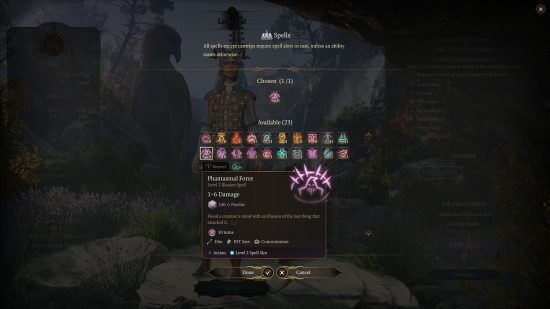
Best Bard spells and leveling
Compared to other classes, the Bard does not prepare spells out of a pool. Instead, you have to select specific spells that will be usable. You won’t be able to access or replace those you’ve chosen until the next time you level up. As such, it’s important to pick those that you really need. Below, we’ve listed what we consider to be the best spells for the Bard in Baldur’s Gate 3.
Level 1
- Charm Person
Level 2
- College of Valour
- Crown of Madness
Level 3
- Mage Hand
- Cloud of Daggers
- Actor
Level 4
- Fear
Level 5
- Knock
Level 6
- Phantasmal Force
Level 7
- Polymorph
Level 8
- Dimension Door
- Ability Improvement (charisma)
Level 9
- Mass Cure Wounds
Level 10
- Minor Illusion
- Confusion
- Call Lightning
- Fireball
Level 11
- Otto’s Irresistible Dance
- Feign Death
- Alert
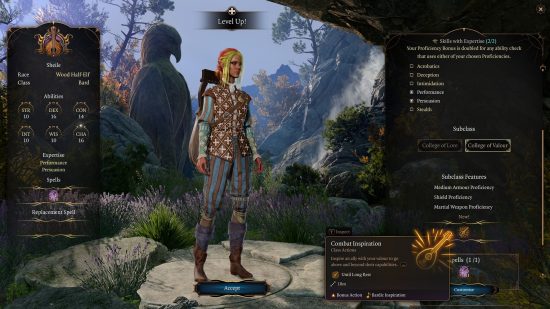
Best Bard equipment
Even if the College of Valour subclass allows the Bard to be more viable in combat situations, you won’t always be in the frontline. As such, you can make do with just a one-handed weapon and a shield, as well as a hand crossbow. Medium armor is also worth using, so don’t worry too much about your defenses.
The best weapon for the bard is:
Markoheshkir
Alleviate the arcane burden of spellcasting with the power of this staff. The next spell you cast doesn’t cost a spell slot.
Baldur’s Gate 3 Bard character creation overview
Here are the key class features, mechanics, and subclasses that make the Bard unique among other support classes.
Class Features
These features and mechanics are available to the Bard by default:
- Dexterity Saving Throw Proficiency
- Charisma Saving Throw Proficiency
- Light Armor Proficiency
- Simple Weapon Proficiency
- Hand Crossbow Proficiency
- Longsword Proficiency
- Rapier Proficiency
- Shortsword Proficiency
- Musical Instrument Proficiency
Unique Mechanics: Starting Instrument and Bardic Inspiration
Starting Instrument – The Bard can choose a Hand Drum, Flute, Lute, Lyre, or Violin as an instrument. This mostly changes the animation style when you cast spells.
Bardic Inspiration – This is the Bard’s bread-and-butter action. This allows you to buff an ally’s attack roll, ability check, or saving throw. You have a limited number of Bardic Inspiration charges (i.e., +3 charges only during early access), which are refreshed once you do a long rest.
College of Valour Subclass features
The College of Valour subclass has these perks:
- Combat Inspiration
- Medium Armor Proficiency
- Shield Proficiency
- Martial Weapon Proficiency
College of Lore Subclass features
The College of Lore subclass provides the following benefits:
- Additional Proficiencies – Arcana, Intimidation, and Sleight of Hand.
- Cutting Words – Use a Bardic Inspiration charge to debuff a target; add a +1d6 penalty to its attack rolls, ability checks, and saving throws. It’s basically a debilitating version of Bardic Inspiration.
If you do go ahead with the best Baldur’s Gate 3 Bard build, familiarize yourself with the BG3 half-elf race, too. And if music is the food of love, then you should prepare for your Baldur’s Gate 3 romance options.
